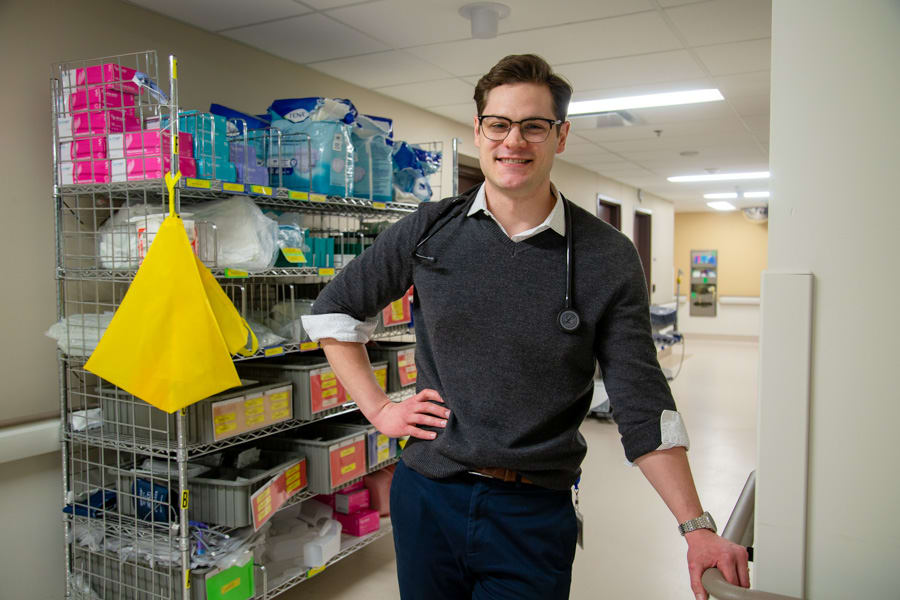The Making of an MD is a multi-story series following a medical school student through training to become a physician. This is Part 3 in the series.

Medical learner Grant Sweeny is a few months into rotations and getting a clearer sense of the type of physician he wants to become.
A few weeks into his internal medicine rotation, Grant Sweeny looks every bit a seasoned physician.
His stethoscope is draped around his neck, always within reach. He also gets to wear “regular human being clothes” every day – one of the perks of internal medicine, he says, which doesn’t require the daily donning of scrubs that other specialties mandate.
Despite that, Sweeny’s four-week foray into a discipline that was on his shortlist of potential career paths has made one thing clear: He wants more scrubs in his wardrobe.
“There’s a lot of fine-tuning of medications and care plan management, and I feel as though it’s rarely completely solving problems,” Sweeny says about internal medicine. “We have someone with a chronic condition coming in with pneumonia, we can fix the pneumonia, but not the other things … and that can remove some of the satisfaction for me sometimes.”
That kind of self-awareness is the point of rotations, also known as clerkship, which started for Sweeny in December. Over the next year and a half, the McMaster University medical student at the Michael G. DeGroote School of Medicine – Niagara Regional Campus (NRC) will explore different medical specialties during placements that last two to four weeks and allow him to apply classroom knowledge to patient care. These hands-on experiences will help Sweeny determine which field best matches his interests and strengths.
He began his journey toward his chosen specialty with some top picks already in mind: family medicine, which his grandfather Dr. George Patrick Sweeny practised, internal medicine and urology.
Neither his first rotation in medical oncology at Juravinski Hospital, a regional cancer centre in Hamilton, nor his second in obstetrics and gynecology at Niagara Health’s Marotta Family Hospital, were among his chosen few. But the experiences they provided will help Sweeny no matter what area of medicine he practises.
During his two weeks in medical oncology, he began laying the foundations of every patient-physician interaction, including taking patients’ medical history and honing his communication skills.
He continued fine-tuning those abilities over four weeks in obstetrics and gynecology, where he witnessed the stark contrast of new parents’ jubilation and the grief of those dealing with stillbirth or miscarriage.
“The idea of shoving everything down is dissipating in medicine. The idea of finding ways to process things is more common so I’m not taking it home to my wife.”
“For the most part, people were excited and happy, and in my case, it was mostly good news,” Sweeny says. “Obstetrics is mostly made up of highs and lows. There are times we have to break difficult news to people and it’s challenging but meaningful, and an important role that no one in obstetrics would shy away from.”
Although Sweeny could be involved in gathering the medical history of a patient who was miscarrying, for example, he deferred to the obstetrician on duty to give the diagnosis and observed the delicate balance of compassion and candour in those moments.
Being part of a patient’s worst moments is as much a privilege as sharing in life’s highlights, he notes.
“It’s an honour, not that I look forward to those conversations. But it is rewarding to have those conversations and let them know what’s going on,” he says. “You have to deliver that news in a way that’s thoughtful and supportive.”
Sweeny learned in class how to navigate emotionally fraught interactions. He was also taught something that generations of physicians who came before him weren’t: The weight of such exchanges isn’t easily shrugged off.
Gone are the days of keeping a stiff upper lip. Sweeny’s generation of medical students is encouraged to take time to reflect, decompress and take care of themselves in the aftermath of those heavy moments.
“I was very intentional afterwards to take time to process,” he says. “The idea of shoving everything down is dissipating in medicine. The idea of finding ways to process things is more common so I’m not taking it home to my wife.”
Back in internal medicine, Sweeny starts his day around 7 a.m. His first task is to log into the Hospital Information System and review the charts of the previous day’s patients to see if any changes were recorded overnight.
Then he meets with his physician preceptor, who can see up to 35 patients a day, and confirms his patient load for the day – up to seven. Sweeny will take the rest of the morning and early afternoon to do his rounds and write notes.
By 2 p.m., he and his preceptor meet to discuss patient cases and decide on management plans. Notes are updated. Patients are filled in on decisions, and by 5 p.m., he calls it a day.
Sometimes Sweeny will work evenings or overnight with the general internal medicine physicians in the Emergency Department at Marotta Family Hospital to help determine which patients should be admitted. There’s the odd weekend shift, too.
“From a medical school perspective, it’s very civilized. They’re conscious not to overload us with the number of patients we see,” Sweeny says. “I get the sense life in internal medicine is different and you’re getting pulled in different directions all the time. We’re spared a lot of that.”
But he’s not spared the insight of what he wants to do when he finishes medical school. Right now, urology is the frontrunner. That comes next in his rotation schedule, with two weeks at Juravinski and another two in London at Western University.
“That will be the test,” he says.

